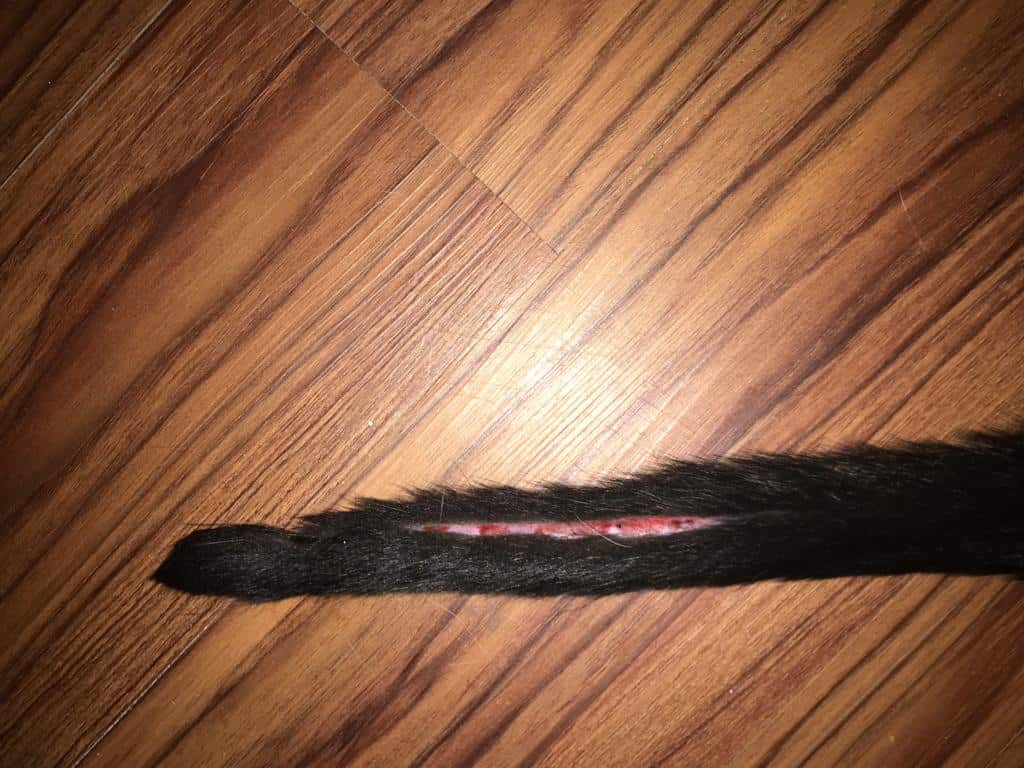A dog’s tail is more than just a furry appendage. It’s an important part of their anatomy, used for balance and communication.
Not only does it provide balance and help with steering while running, but it is also used for communication.
A wagging tail can indicate happiness or excitement, while a tail between the legs can signal fear or submission.
By paying attention to their tails, dogs can communicate with each other and with humans.
Because of a dog’s tail’s importance in communication, every pet parent needs to know if and when there is an issue.
To keep you in the know, this post will answer one of the most common concerns dog parents have—whether or not their Fidos can break their tails—plus a bunch of other dog tail-related questions.
Let’s dive right in…
So, Can A Dog Break Its Tail?
The tail of your dog is made up of lots of tiny bones. Depending on the breed, your dog might have anything from 15-25 bones in the tail.
These bones are connected by muscles and ligaments, which allow the tail to move.
The base of the tail is thick and muscular, while the tip is usually thinner and more flexible.
This flexibility allows dogs to express a range of emotions through their tail movements including aggression, happiness, and stress among other emotions.
Because the tail is made up of tiny bones, it can break. It is essentially a skeletal structure, meaning it can fracture when exposed to a certain amount of force.
This can happen the same way you can sprain or break your arm or leg.
Dogs with more bones are especially susceptible to serious injuries as the bones can easily get fragmented.
A broken tail can swell, bend or create a kink in it making wagging and moving the tail painful.
Thankfully, this is quite rare and usually only happens if the tail is hit with a lot of force—for instance, if the dog is involved in an accident, hits the tail against something, or gets stepped on.
Tail fractures are most common in young puppies since their bones are not yet fully developed.
Some of the common broken tail injuries include:
- Lacerations (deep cuts that expose bone and muscle)
- Abrasions (simple scrapes)
- Happy tail(bleeding ulcers because of non-stop wagging)
- Fractured tail (breakage of the vertebrae)
- Cold or limber tail (painful muscle caused by overexertion)
- Nerve damage (injury to the tail nerves).
What Does A Broken Dog Tail Look Like?

When a dog’s tail is broken, it typically takes on a twisted or bent appearance.
The tail may also be held at an unusual angle or may hang limply to one side.
In some cases, the broken tail may cause the dog to walk with a limp.
If the break is severe, there may be signs of bleeding or deformity.
In most cases, a broken tail will heal on its own with time and rest.
However, if the break is severe or if there are signs of infection, veterinary care may be necessary.
The following are the signs of a broken tail in a dog:
- The tail may be held at an unusual angle or may hang limply to one side.
- The dog may walk with a limp.
- There may be signs of bleeding or deformity.
- Kink in the tail
- Swelling or bruising around the tail
- Pain or sensitivity when the tail is touched
If you notice any of these signs, it’s important to take your dog to the vet as soon as possible.
They will be able to properly diagnose the problem and provide the necessary treatment.
Can Dogs Break Their Tail By Wagging?
While a dog’s tail is very flexible, it is not indestructible.
Even though rare, a dog can break their tail by wagging. This can happen if the dog hits the tail against an object thereby resulting in the breaking of the tailbones.
In severe cases, this can cause paralysis.
However, this is quite rare; most cases of tail injuries in dogs are due to trauma.
Dogs that are born with abnormally short tails are also more susceptible to tail injuries.
How Do You Tell If A Dog’s Tail Is Sprained?
If your dog is walking with a stiff tail or you notice that they are holding their tail lower than normal, they may have sprained it.
To tell for sure, gently palpate the length of the tail. If your dog yelps or if you feel any knots or unusual bumps, take them to the vet as soon as possible.
While waiting for the vet, you can help your dog by creating a splint for their tail using a rolled-up magazine or piece of cardboard.
Just be sure to wrap it snugly but not too tightly, and check periodically to make sure that the splint is still in place.
Should I Wrap My Dog’s Sprained Tail?
When it comes to treating a sprained tail, there is no one-size-fits-all answer.
The best course of action will depend on the severity of the injury and the dog’s circumstances.
In some cases, wrapping the tail with a bandage can help to stabilize the joint and reduce swelling.
However, this is not always necessary, and it’s important to avoid constricting the tail too tightly.
If you’re unsure whether or not to wrap your dog’s tail, it’s best to consult with a veterinarian.
They will be able to advise you on the best course of treatment based on your dog’s individual needs.
How Long Does A Broken Tail On A Dog Take To Heal?

A broken tail on a dog can take anywhere from several weeks to several months to heal fully, depending on the severity of the break.
In some cases, surgery may be required to realign the bones and prevent future problems.
However, even with surgery, it can still take several weeks for the tail to heal properly.
During this time, it is important to keep your dog calm and quiet to avoid further injury.
This may mean restricting exercise and avoiding situations that could cause your dog to wag its tail excessively.
With proper care, most dogs make a full recovery from a broken tail within a few months.
How to Treat a Broken Dog Tail
A broken dog tail can be a painful and frustrating injury for both you and your pup.
Though it may seem like a minor injury, a broken tail can cause serious health problems if left untreated.
Fortunately, there are a few simple steps you can take to help your dog heal and feel comfortable again.
First, try to keep your dog calm and quiet. This will help to prevent further damage to the tail and allow the healing process to begin.
You may also want to use a splint to restrict movement in the tail as much as possible. A piece of cardboard can make a good splint.
Once you have done this, take your dog to the vet as soon as possible.
Do not attempt to treat a broken tail at home because it is a serious injury that requires professional medical attention.
Upon examination, the vet might decide to take your dog into surgery although it is also possible for the dog to be treated through nonintrusive means – it all depends on the extent of the injury.
What to Do If You Slam a Dog’s Tail on the Door

If you accidentally slam a door on your dog’s tail, it’s important to take quick action.
First, check to see if the tail is bleeding. If there is any blood, call your veterinarian right away.
If the bleeding is minor, you can try to stop it by applying pressure with a clean cloth.
Once the bleeding has stopped, give your dog some pain relief medication and monitor them closely for the next few hours.
If you notice any signs of discomfort or distress, call your vet immediately.
If the tail appears broken, take your dog to the vet immediately, even if there is no blood.
Taking quick and appropriate action will help ensure that your dog heals quickly and doesn’t experience any long-term problems.
How Much Does It Cost To Fix a Broken Dog’s Tail?
There is no one-size-fits-all answer to this question, as the cost of repairing a broken tail will vary depending on the severity of the injury and the type of treatment required.
However, it is generally safe to say that fixing a broken tail will not be cheap.
You should be ready to part with anything from $100 -$600 to have a vet treat your dog.
However, this figure does not take into account the cost of pre-operative testing, post-operative care, or any other additional charges that may apply.
Given the high cost of treatment, many pet owners choose to amputate their dog’s tail rather than pay for surgery.
While this may be a less expensive option in the short term, it can lead to long-term health problems for your dog.
As such, it is important to think of suitable pet insurance that can take care of such accidents if they occur.
Breeds Are More Likely To Break Their Tail
It would be safe to infer that dogs that have longer tails are more likely to break their tails than those with shorter ones.
For instance, it is easier to slam a dog’s tail in the dog if the tail is longer.
The tails typically break at the base or in the middle and the breeds that are most at risk include Australian Shepherds, Cocker Spaniels, and Labrador Retrievers.
Dogs with shorter tails, such as Bull Terriers and Boxers, are less likely to break their tails.
In addition, mixed-breed dogs tend to have sturdier tails than purebreds.
This might be because mixed breeds typically combine the best of traits from both parents.
Summary
A broken tail is a serious injury that can cause long-term health problems for your dog if it is not treated properly.
That is why it is important to have your dog attended to by a vet as soon as you discover an issue with the tail.
The cost of treatment can be expensive, but it is worth it to ensure that your dog heals properly.
In an ideal situation, your dog should recover within weeks and get back to his usual self.
As an Amazon Associate, we may receive a small commission from qualifying purchases but at no extra cost to you. Learn more. Amazon and the Amazon logo are trademarks of Amazon.com, Inc, or its affiliates.

